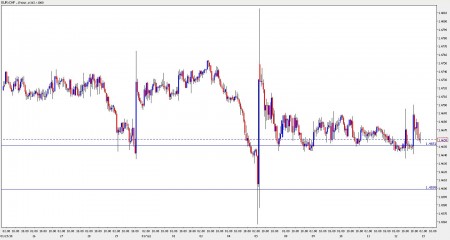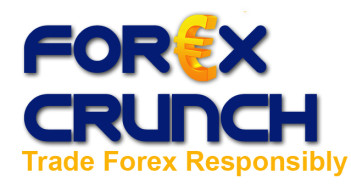The Swiss central bank has increased its interventions in the markets in an attempt to weaken the Swiss Franc. The moves are seen best against the Euro. Here is how it looks on the graph + a few characteristics of these moves.

Click to enlarge. Remember that interventions are short lived.
Observing the graph of EUR/CHF, the interventions are clearly seen. The first one is on Friday, January 29th at around 17:00 GMT, near the end of day. The SNB didn’t like the 1.4650 level and sent the pair up.
The second is much stronger – it happened on Friday, February 5th at around 2:00 GMT. The intervention had a stronger effect during the Asian session, after EUR/CHF fell to almost 1.4550. But also here, the effect didn’t last for a long time.
When was the third intervention? You guessed right – the next Friday. On February 12th, the SNB made a minor push during the busy London session and made a stronger move at around 15:00 GMT, as it eyed 1.4650 once again. It’s still to be seen how this will evolve.
Why does the bank intervene?
The Swiss economy is based on exports – Switzerland has a surplus in it’s trade balance. The main trading partners come from the Euro-zone – Germany, France, Austria and Italy all border the Alp nation. A weaker currency means more value for exports.
We’ve seen interventions in the past, but now they happen more often. There’s a reason for that as well – the SNB has a new boss -Philip Hildebrand. His policy much more pro-active than the former chief Jean-Pierre Roth.
Roth defended the round 1.50 line for quite some time. This eventually failed.
Larger impact on forex
While the interventions are usually short lived, and the SNB eyes only the EUR/CHF, this immediately has an effect on USD/CHF – a major pair. The Swiss Franc used to be a “safe-haven” currency that is sought in times of trouble.
In the current crisis, the Japanese Yen and the US dollar played this role. The absurd was that when bad news came out of the US, the dollar strengthened – serving as the “safe currency”. This trading behavior has significantly weakened since December 4th – when good American Non-Farm Payrolls sent the US dollar up.
The Swissy isn’t in this game anymore. It moves by speculators and the performance of the Swiss economy, which is doing well without interventions. The Swiss National Bank still wants it to fall.
But despite the SNB’s efforts, the currency is still strong. What the bank achieves is making it an unsafe currency. These jumps make it very unpredictable. I’ve already said that the Australian dollar should replace the Swissy as a “major pair”.
Are you trading the USD/CHF or EUR/CHF?
Want to see what other traders are doing in real accounts? Check out Currensee. It’s free.
